New perk! Get after it with local recommendations just for you. Discover nearby events, routes out your door, and hidden gems when you sign up for the Local Running Drop.
The dirt on this season’s latest and greatest
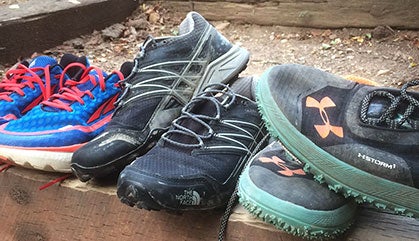
I once heard a panel speaker say, “Interesting things happen near the fences.” This particular panel was devoted to genre-straddling fiction, but the statement could apply equally to the booming trail-shoe market, born at the boundaries of running, mountaineering and other outdoor-adventure sports.
At August’s Outdoor Retailer convention, we saw a dizzying array of new trail-running shoes. Established brands like Brooks, Nike and New Balance bring their expertise in road and track to off-road running. Others, such as La Sportiva and Scarpa, have been manufacturing mountaineering boots and climbing shoes for decades. Vasque and Merrell draw on hiking, while Dynafit and Salewa make mountain-running shoes that serve the training needs of their off-season ski-mountaineering athletes. Adidas Outdoor and Under Armour have looked to mountain biking for next-level tread, and onetime upstarts like Hoka and Altra continue to redefine what a running shoe can look like.
This diverse mix of design philosophies—and the panoply of shoes it’s yielded—makes it very good to be a trail runner right now. Here are 10 of our favorite models this season.
The North Face Ultra MT
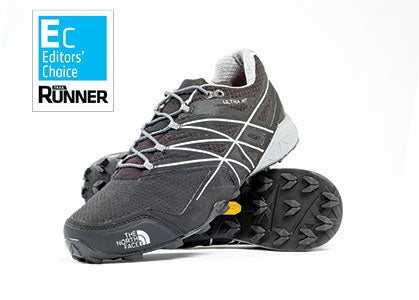
10.4 oz | 8mm drop | $130
“The Ultra MT is a beast,” declared one wear tester after putting it through 100 or so miles of wringer. Indeed. With its well-constructed ripstop upper, rock protection and monster sticky-rubber lugs, The North Face’s latest creation eats up the toughest trails. From soft, wet ground to hard, slick roots to loose, sandy climbs, the tread held; more than one tester used the word “trust” when talking about the shoe’s traction.
Because of the midsole stiffness and relative lack of cushioning, the Ultra MT can get uncomfortable on longer runs, especially ones with lots of hard, flat stretches. But on technical, treacherous terrain, it’s hard to beat.
Fit: True to size. Fairly narrow in the forefoot.
Bottom line: When the going gets rough, this shoe gets going.
Tester-monial: “I’d save them for my most technical runs of any distance. On a rocky, muddy ultra I think they’d be terrific.”—Maura Adams, Penacook, NH
Salomon Speedcross Vario
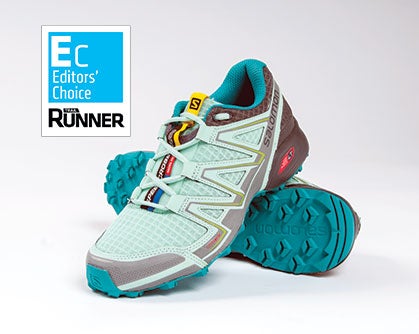
9.6 oz | 11mm drop | $110
The Speedcross Vario feels fast from the first step, due to the locked-in fit and responsive, flexible midsole. The supportive upper lends enough confidence to tackle the most technical, off-camber terrain, while remaining extremely comfortable—plush, almost—and unconstricting.
With less aggressive lugs than the rest of the Speedcross line, the Vario’s tread delivers on soft and hard surfaces alike—one tester praised its grip on “mud, scree and that light morning dew that makes large rocks more like hunks of ice”—but didn’t feel jarring on pavement.
The cushioning is enough for short to medium runs, but on the minimal side for longer efforts, especially on rocky terrain or pavement.
Fit: On the small side, length-wise. Snug in the heel and midfoot, with a somewhat roomy toebox. Uncharacteristically for Salomon, the Vario has traditional rather than speed laces.
Bottom line: A supportive, agile shoe for flying on technical trails.
Tester-monial: “These shoes live up to their name. They are fast and smooth and just make you want to push your pace up 30 seconds.” —Jason Miller, Austin, TX
Hoka One One Speedgoat
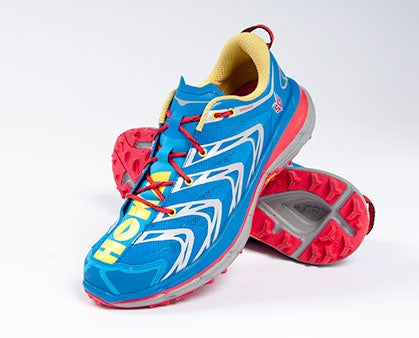
9.7 oz | 5mm drop | $140
Adopting the nickname of 100-mile legend Karl Meltzer, the Speedgoat brings burly tread and protection to the high-cushion, aggressively rockered platform Hoka is known for. The sticky Vibram outsole and multi-directional lugs grip slick surfaces and dig into mud and loose sand, and the thick, responsive midsole provides ample rock protection.
The Speedgoat’s grooved sole makes it feel relatively flexible and agile for a max-cushion model, though some testers found the shoe didn’t have enough support for loose or off-camber terrain. The thin, open-mesh upper breathes and drains extremely well—perhaps a bit too well, said testers who found themselves periodically dumping out sand and dirt that filtered in.
Fit: True to size. Reasonably wide, though it tapers enough in the front that some testers wished for more pinkie-toe room.
Bottom line: A max-cushion mountain runner with bomber tread.
Tester-monial: “The best outsole ever found on a Hoka model, with strategically placed lugs that provide superb traction under all conditions.” —Linh Shark, Olympia, WA
Under Armour Fat Tire
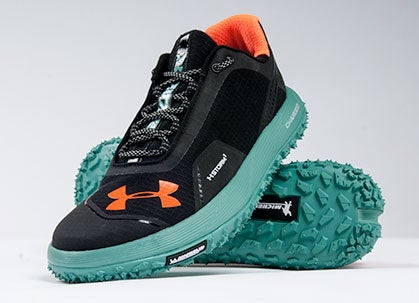
13 oz | 9mm drop | $149
Taking inspiration from another off-road sport, the Fat Tire has a knobby Michelin outsole modeled on a mountain-bike tread, and a fat, rockered midsole, meant to roll over rough terrain like a low-pressure tire.
An innovative concept, it yielded mixed results in practice. The tread delivered superior traction on all surfaces, from dry dirt to slick, wet boulders, and the forgiving midsole made jagged rocks imperceptible.
On firmer terrain, though, the cushion felt soft to the point of squishiness, and the midsole, rounded on all sides, lilted left and right as well as rolling forward. “It feels like you’re balancing on a road-bike tire,” complained one tester. All this conspired to make footfalls imprecise on technical terrain and unstable on hardpack or asphalt flats, especially at a moderate or faster pace. The Fat Tire is best saved for fastpacking, trekking or slower run-hikes where speed and agility take a backseat to comfort and protection.
Fit: True to size, and comfortably snug.
Bottom line: An intriguing experiment that ultimately falls short as a running shoe in most circumstances.
Tester-monial: “These shoes are really for beginner trail runners or hikers who expect forgiveness and comfort in each step. Experienced trail runners will find them too unsure, unforgiving and heavy.” —Justin Lottig, Honolulu, HI
Inov-8 Terraclaw 250
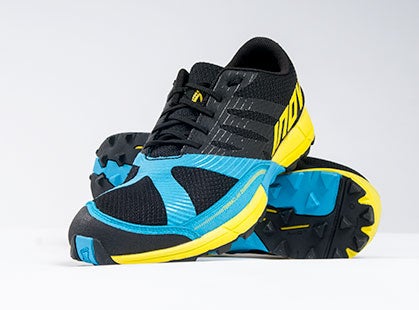
8.8 oz | 8mm drop | $130
The Terraclaw 250 is built for runners who prize agility but like a higher drop and greater structure than a more minimal shoe provides.
The midsole takes some breaking in; it ends up feeling fairly pliable on twisty, rock-strewn terrain, if a bit flat on even hardpack and road. The X-shaped forefoot overlay keeps the fit secure, especially on steep descents (though it may be uncomfortably constricting against higher insteps).
The triangular lugs, adept at shedding muck and debris, performed best on soft, damp trails with a lot of up and down.
Fit: True to size, with a wide enough, but not roomy, toebox.
Bottom line: A shoe for rock-hopping mountain goats who like a moderate amount of protection.
Tester-monial: “The lugs weren’t too tall, but not too short, just perfect. On the muddier sections, the shoes didn’t hold on forever, but gave plenty of traction to not slip.” —Jonathan Loewus-Deitch, Washington, DC
Icebug Zeal RB9X
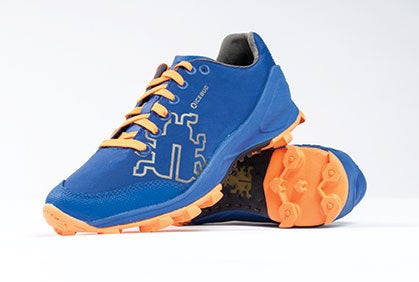
8.8 oz | 6mm drop | $170
With its narrow last, sturdy upper and well-spaced lugs topped with small rubber spikes, the Zeal reminded one tester of “soccer cleats.” Testing proved this comparison apt in more ways than one. The unique tread inspired confidence on every surface imaginable—mud, wet rock, packed snow, creek crossings and damp forest trail, to name a few.
Inevitably, a specialized shoe like the Zeal comes with tradeoffs. The aggressive lugs made running on pavement and, to an extent, hardpack, uncomfortable. The thin midsole aided ground feel but didn’t provide the protection or cushion for longer runs. The tightly woven upper, impervious to debris, limited breathability. And the hard plastic that extends along the inner midfoot, presumably for lateral stability, struck some as rigid and awkward.
Fit: True to size, if not a bit long, and quite narrow.
Bottom line: If you’re looking for a jack-of-all-trails shoe, this isn’t it. But a solid choice for the cold muck of early spring, mud runs and obstacle races.
Tester-monial:“A great ‘Vertical K’ shoe, given its light weight, sticky sole and deep lugs.” —Hank Dart, Hailey, ID
Vasque Pendulum II
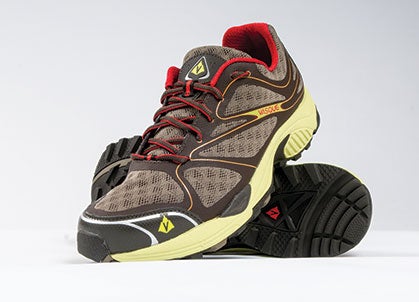
10.2 oz | 6mm drop | $120
Vasque’s web blurb for the Pendulum II begins, “The Middle Way, or so the Buddha taught.” How the Eightfold Path might apply to the modern running-shoe market falls outside our expertise. But by all prosaic measures, the Pendulum II achieves remarkable balance. The shoe feels supportive and surprisingly agile, with good ground feel but enough cushioning for longer distances. The workhorse tread gripped wet rocks and logs, dug into soft, muddy trails and stayed out of the way on hardpack and pavement.
The complaints we heard singled out the upper. Though they appreciated the breathability, some testers found the thin, stiff materials chafed on longer runs, and wished for more padding around the ankle and under the tongue.
Fit: Runs large. Snug in the midfoot, with a fair amount of room in the toebox.
Bottom line: A well-balanced shoe with sturdy construction, support, responsiveness, ground feel and get-‘er-done tread.
Tester-monial: “The Pendulum II performed with impressive agility over varied terrain and provided immediate response time for an incredibly nimble feel.” —Nick Sparr, Iowa City, IA
Altra Paradigm 1.5
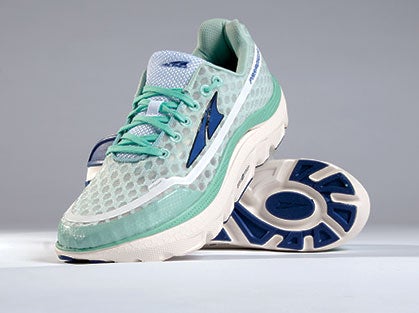
9.7 oz | 0mm drop | $130
The Paradigm 1.5 is about as cushioned as it gets, but feels quite light due to the airy upper and minimal outsole rubber, limited to strike zones. Testers appreciated the thick midsole during long runs, ultras and recovery days. The unaggressive tread—wide, shallow lugs and deeper grooves—worked well on mixed-terrain runs that alternated between pavement, dirt and gravel roads and dry, mellow singletrack. On wet or technical trails, testers felt less secure. Some testers found them a tad clunky on the roads.
Fit: True to size. Secure and spacious in all the right places: snug in the heel and midfoot, with a roomy toebox.
Bottom line: A comfy, cushioned road-to-trail trainer for zero-drop runners.
Tester-monial: “Super comfortable all day long, pounding out the miles. There are lots of road-and-trail combinations that this shoe is great for.” —Lauren Arnold, Polson, MT
Nike Air Zoom Wildhorse 3
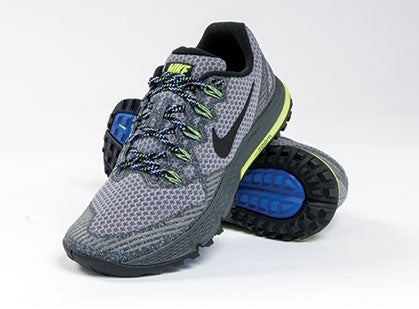
10.8 oz | 8mm drop | $110
The latest update to the Wildhorse includes increased cushioning, underfoot rock protection and a higher heel-toe drop, but preserves the agility of its predecessor. The responsive midsole is cushioned enough to “float,” as one tester said, over trail and pavement alike, and the upper sits squarely in Goldilocks territory: supple yet protective, supportive yet unconstricting, breathable but not airy. Testers reserved their highest praise for the fit, which hugs the heel and midfoot but flares out comfortably in the toebox.
The moderate tread is adequate for many surfaces and transitions easily to road, though the tightly spaced lugs don’t have enough bite for muddy trails or tight, technical turns.
Fit: True to size. Secure through the midfoot, with a roomy toebox.
Bottom line: A comfortable, versatile shoe for all but the toughest terrain.
Tester-monial: “The break-in period was minimal and painless. The Wildhorse 3 ended up being my go-to shoe for just about every type of run.” —Joel O’Polka, Lone Tree, IA
Merrell All Out Terra Trail
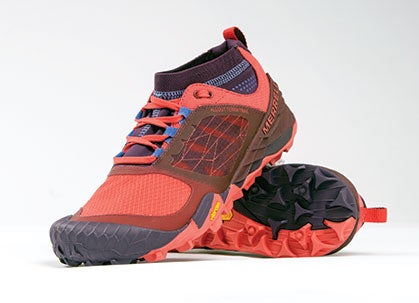
10.5 oz | 6mm drop | $120
One look at the Terra Trail tells you it’s an off-road animal. The rubber toe bumper, abrasion-resistant upper and built-in bootie protect the foot from all sides, and the traction is superb: aggressive triangular lugs—some topped with smaller rubber knobs—bite into snow and mud and grip well on off-camber rock. One tester even wore the shoes while fencing on wet grass.
There’s minimal cushioning under the forefoot, promoting ground feel and flexibility but making small, sharp rocks uncomfortable. And while testers liked the idea of the bootie, they had mixed reactions to it in practice.
Fit: True to size. Secure in the heel and midfoot, with a wide toebox that allows for splay.
Bottom line: A great shoe for the worst conditions: sloppy trails, rocky scrambles, brambly bushwhacks and the like.
Tester-monial: “A great addition to my inventory. I don’t think I would wear them every day, but they’ve been awesome on my technical, mountain-ascending training days.” —Joel Axler, Flagstaff, AZ